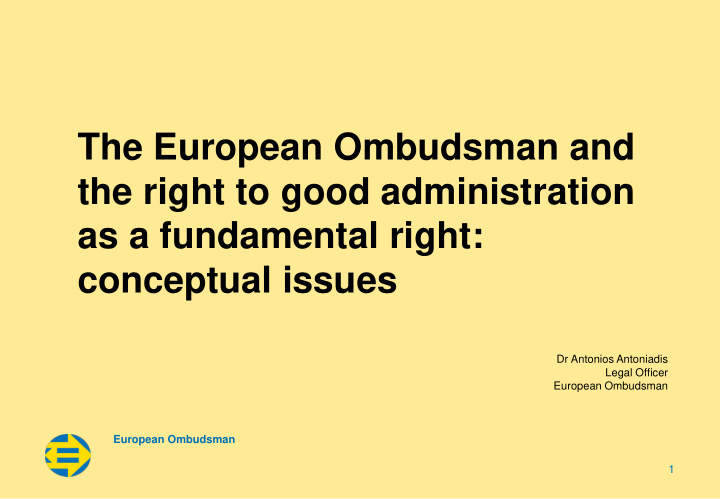



The European Ombudsman and the right to good administration as a fundamental right: conceptual issues Dr Antonios Antoniadis Legal Officer European Ombudsman European Ombudsman 1
Outline Introduction The development of the Ombudsman’s office The Ombudsman’s mandate Who? Against whom? About what? Maladministration and the right to good administration An insider’s view Procedure Practice European Ombudsman 2
Introduction Establishment and historical development of the Ombudsman Institutional prehistory and the coming of age 1995 – 2003: Söderman 2003 – 2013: Diamandouros : O’Reilly 2013 - The Ombudsman’s Office Location (Strasbourg-Brussels) Staff (75 of which 20 legal officers) Website: www.ombudsman.europa.eu Languages European Ombudsman 3
The Ombudsman’s mandate Article 228 TFEU A European Ombudsman…shall…receive complaints from any citizen of the Union or any natural or legal person residing or having its registered office in a Member State concerning instances of maladministration in the activities of the Union institutions, bodies, offices or agencies … The Ombudsman shall conduct inquiries for which he finds grounds , either on his own initiative or on the basis of complaints submitted to him directly … Where the Ombudsman establishes an instance of maladministration, he shall refer the matter to the institution … concerned. … The EO Statute The Implementing Provisions European Ombudsman 4
Conceptual issues I: What is maladministration? Definition: (AR1998) “ Maladministration occurs when a public body fails to act in accordance with a rule or principle which is binding upon it ” Illegality Maladministration Content: Maladministration v. unlawfulness ( “There is life beyond legality ”) Principles of good administration and human rights European Ombudsman 5
Conceptual issues I: What is maladministration? The European Code of Good Administrative Behaviour The ECGAB was proposed by the Ombudsman and approved by the Parliament in 2001 as a follow-up to the Charter The Ombudsman makes use of the Code in the context of her inquiries. The Code includes principles such as lawfulness, absence of discrimination, proportionality, absence of abuse of power, impartiality and independence, objectivity, fairness and courtesy. European Ombudsman 6 6
Conceptual issues II: What is good administration? Article 41 CFREU – Right to good administration 1. Every person has the right to have his or her affairs handled impartially, fairly and within a reasonable time by the institutions and bodies of the Union. 2. This right includes: the right to be heard; the right to have access to his or her file; the obligation of the administration to give reasons for its decisions. 3. The right to have the Community make good any damage caused by its institutions or by its servants. 4. Every person may write to the institutions of the Union in one of the languages of the Treaties and must have an answer in the same language. European Ombudsman 7
Conceptual issues II: What is good administration? A. Scope of the principles of good administration Examples: Article 10 ECGAB (“ legitimate and reasonable expectations ”) Article 11 ECGAB (“ The official shall act impartially, fairly and reasonably ”) B. The Charter as primary Union law European Ombudsman 8
Conceptual issues and practice Infringement cases (Article 258 TFEU) Communications 2002 and 2012 Transparency: Access to documents Regulation 1049/2001 Staff cases – Recruitment (EPSO) Awards of tenders or contracts Institutional and policy matters Provisions on democratic principles (Articles 9-11 of the TEU, specifically, the ECI) Ethics (Conflicts of Interest, Revolving Doors) Improving the culture of service (Public Service Principles for EU officials) European Ombudsman 9
Conceptual issues and practice: A comparison with the Court of Justice Ombudsman Court of Justice Actio popularis Locus standi Proactive role Reactive role Scope of inquiry: broad Scope of review: narrow Remedies: no binding Remedies: binding interpretation, no binding interpretation, annulment remedies of acts European Ombudsman
Procedure The Registry → Outside the Mandate → Advice/Transfer (Europe Direct, SOLVIT, European Commission, National/Regional Ombudsmen, Consumer bodies) Complaints and Inquiries Units Admissibility → Grounds Inquiry (Inspection of documents/Hearing of witnesses) Simplified procedures No maladministration Friendly solution proposal Draft recommendations Critical remark/Further Remark Special report European Ombudsman 11
Statistics Year Number of Opened Closed complaints inquiries inquiries 2011 2510 396 318 2012 2442 465 390 European Ombudsman 12
Statistics Complaints against European Commission 245 European Personnel Selection 78 Office European Parliament 24 European External Action Service 14 European Investment Bank 7 Other (EU agencies) 97(58) European Ombudsman 13
Statistics Results 2012 Settled by the institution or friendly 80 solution accepted No further inquiries justified 197 No maladministration 76 Maladministration found 56 Other 15 European Ombudsman 14
Conclusions The Challenge Ahead The European Ombudsman, the right to good administration and the European Union in crisis European Ombudsman 15
Recommend
More recommend